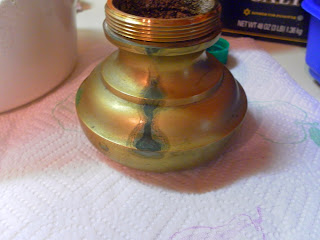John Martin's SPOOL PETS KITTY CAT NO. 1.
 |
| Wooden Display of Spool Pet Miss Kitty aka Kitty Cat No. 1. |
Her green eyes captured my heart and made me smile. Back in 2011 when I was researching my wooden advertising display version of John Martin's SPOOL Pets KITTY Cat No. 1. I learned she was inspired by a J&P Coats and Clark O.N.T.* thread trading card copyrighted in 1930.
*Note: O.N.T. - Clark's O.N.T. thread - What O.N.T. stands for, according to the "All Things Ruffnerian" blog, "In 1806, Napoleon blockaded Great Britain, which meant that silk thread was not available to British weavers. The Clark family had a loom supply company and they were also big suppliers of silk thread.At the time of the blockade, Peter Clark developed a method of combining cotton threads so that they were strong and smooth enough to be used in place of silk, and he advertised this important advancement as "Our New Thread."


My finding was, whether created by an individual or provided by the J.P. Clark Company, she was used as display. She is obviously screen printed (as apposed to hand painted) and would have been sitting on top of a wooden Coats and Clark thread display. Her dimensions are 4" tall x 2 1/4" wide x 2 1/2" deep. She bears no manufacturers markings and was attached to a large spool of J.P. Coats black thread. Highly lovable right down to her soiled natty little tail! She was my fourth sale and sold for $29.00 not including shipping. Although I was sad to see her go, she was adopted by a "good home" and is loved.
Initially there were 6 pets available 1. KITTY CAT, 2. PUPPY DOG, 3. BOB BUNNY, 4. HAL HORSE, 5. CLARA COW and 6. PETE PIG. Each of which were included in your purchase of Coats and Clark bias trim or you could send 5 cents to THE SPOOL COTTON COMPANY, Dept. 101, P.O. Box 551, Newark, New Jersey if you wanted all six. A First Class stamp was 3 cents in 1930.
Now days they'd be downloadable on the companies web site or blog. Hey, some are!
Coats and Clark blog has a wonderful bit of history including the second release of a Spool project called "Spool Zoo". You can read all about it there and you'll find a great free downloadable graphic perfect for a child's tee-shirt project.
 |
| John Martin's SPOOL PET No. 1. KITTY CAT via Pinterest |
According to
http://www.thepeoplehistory.com/ in the 1930's, depending on where you lived, a nickel would purchase a loaf of bread, or a can of pork and beans, or one pound of fresh peas, or a couple of oranges, or a half a gallon of gas. In other words, a nickel could be important to a family during the Depression.
My mother, born in 1926 to a farming family, had very few toys when growing up resulting in a love of toys as an adult. Educated as a Home Economics teacher she passed on the love of sewing and all things crafty. So, when I had to choose an avatar for myself when I opened my vintage shop on Etsy, I couldn't think of anything better than Kitty to represent me as an avatar. Kitty knows good vintage! Kitty embodied a part of my past, my family's past, and certainly my present. Who could ask for more?
 |
| Kitty knows good vintage! |
I imported a photograph of her into GIMP a free image editing program and "posterized" her. I love that I see her everyday. She's a playful reminder of our past, how vintage and handmade go hand in hand, and is steeped in American history.
When a new Google+ friend asked about my avatar, commenting that she looked similar to a baby toy of hers handmade by her mother, I decided to create this post. That's one of the lovely things about selling vintage. It pricks at memories, the little things that really aren't so little, which sometimes become the "thread" used to create and share family stories, traditions and heirlooms. For me, it doesn't get any better than that. If +Margaret Siemers found her toy pictured below:
Meet Kitty Kye who inspired this post.
 |
| Made in the 1950's by Margaret's mother in anticipation of her birth Kitty Kye. |
Margaret says Kitty Kye's body was from a kit. Kye is 8" tall and 6" wide constructed with a feed-sack front and muslin back, I see researching vintage cat toy kits in my future! She wonders if the embellishments were Spool Pet inspired. Could be?While I can't answer that, I can say Kye's adorable and in fabulous condition!
If you have a Spool Pets story you'd like to share add it to the comments below.














